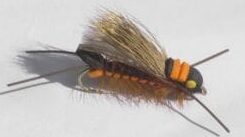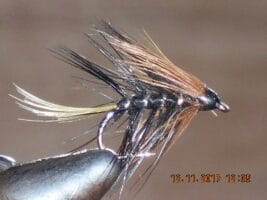Your cart is currently empty!
Orange Salmon fly hopper
Catch more trout and salmon with the Orange Salmon Fly Hopper. Durable, lightweight, and locally crafted for rivers, streams, and low-water summer fishing.
Description
The Orange Salmon Fly Hopper represents an innovative fusion of traditional salmon fly tying and terrestrial pattern design. This unique pattern combines the attractive qualities of orange, a proven salmon-catching color, with the distinctive silhouette of a grasshopper, creating a versatile pattern that excels in both summer salmon fishing and periods of terrestrial activity. Born from the creative minds of modern fly tiers, this pattern has proven particularly effective during low-water conditions and when salmon are holding in shallow lies.
The pattern’s effectiveness stems from its carefully engineered components:
- Premium orange dubbing blend
- High-visibility foam body
- Quality hackle materials
- Rubber leg additions
- Durable synthetic wings
- UV-enhanced materials
- Specialized hook design
- Strategic weight distribution
Each element serves a specific purpose in the pattern’s presentation and durability, creating a highly visible and attractive pattern that combines the best attributes of both salmon flies and terrestrial patterns.
Technical Specifications
Hook Characteristics:
- Heavy-gauge salmon hook
- Available sizes: 2-8
- Strong wire construction
- Up-eye design
- Chemically sharpened points
- Wide gape configuration
- Corrosion-resistant finish
Material Properties:
- High-float foam body
- Premium synthetic materials
- Reinforced construction
- UV-resistant components
- Water-shedding treatments
- Enhanced visibility features
- Durable rubber legs
- Specialized wing materials
Construction and Tying Process?The pattern’s success relies on precise construction methods:
- Balanced proportions
- Symmetrical design
- Graduated body tapering
- Reinforced thread base
- Strategic material placement
- Enhanced durability features
- Proper leg positioning
- Wing angle considerations
Fishing Applications and Techniques
Presentation Methods:
- Traditional swing
- Dead-drift approaches
- Skated presentations
- Wake inducing tactics
- Multiple retrieval options
- Surface disturbance
- Depth variations
- Current manipulation
Specialized Applications:
- Low water conditions
- Summer salmon fishing
- Terrestrial periods
- Clear water situations
- Evening presentations
- Surface-oriented fish
- Shallow lies
- Bank fishing
Seasonal Effectiveness
Summer Peak Performance:
- Prime terrestrial season
- Warm water conditions
- Low water periods
- Extended daylight
- Evening rises
- Surface activity
- Temperature peaks
- Optimal visibility
Early Fall Applications:
- Transitional periods
- Cooling waters
- Changed light conditions
- Pre-spawn behavior
- Mixed techniques
- Weather changes
- Water level variations
- Temperature drops
Late Spring Strategy:
- Early season brightness
- Rising water temperatures
- Initial salmon runs
- Fresh fish behavior
- Varied water conditions
- Light adaptation
- Pattern visibility
- Fish activity
Habitat and Water Types
River Applications:
- Medium-sized rivers
- Large salmon waters
- Shallow runs
- Holding pools
- Current seams
- Bank water
- Boulder gardens
- Tailouts
Specialized Environments:
- Clear water conditions
- Moderate flows
- Shallow flats
- Deep channels
- Complex currents
- Structure areas
- Gravel bars
- Undercut banks
Target Species and Behavior
Primary Species:
- Atlantic Salmon
- Pacific Salmon
- Sea-run Browns
- Steelhead
- Resident Browns
- Large Rainbow Trout
Feeding Behaviors:
- Aggressive takes
- Surface interest
- Pattern recognition
- Territorial response
- Opportunistic feeding
- Chase instinct
- Strike triggers
- Visual stimulation
Rigging Recommendations
Leader Setup:
- 9-12 foot leaders
- 0X-3X tippet
- Tapered construction
- Fluorocarbon options
- Loop-to-loop connections
- Shock absorption
- Proper stiffness
- Knot strength
Presentation Configurations:
- Single fly rigs
- Dropper options
- Indicator setups
- Traditional methods
- Modern techniques
- Line matching
- Leader design
- Tippet selection
Professional Applications
Guide Usage:
- Client-friendly pattern
- Proven success rates
- Visibility advantages
- Easy casting
- Multiple techniques
- Teaching tool
- Confidence pattern
- Versatile applications
Commercial Success:
- Professional acceptance
- Market demand
- Pattern variations
- Size options
- Color adaptations
- Regional preferences
- Seasonal popularity
- Distribution channels
Care and Maintenance
Post-Fishing Care:
- Thorough drying
- Material grooming
- Hook point inspection
- Leg straightening
- Wing adjustment
- Float restoration
- Storage preparation
- Salt removal
Storage Requirements:
- Dry environment
- UV protection
- Separate compartments
- Regular inspection
- Moisture prevention
- Temperature control
- Light protection
- Ventilation needs
Advanced Fishing Methods
Presentation Techniques:
- Reach casts
- Pile casts
- Aerial mends
- Stack mends
- Curve casts
- Roll casting
- Spey techniques
- Switch casting
Drift Management:
- Line control
- Leader design
- Casting angle
- Mending techniques
- Drag prevention
- Current reading
- Speed control
- Pattern tracking
Environmental Considerations
Conservation Features:
- Barbless options
- Sustainable materials
- Durable construction
- Catch-and-release friendly
- Minimal environmental impact
- Eco-conscious design
- Material selection
- Ethical considerations
Material Selection:
- Responsible sourcing
- Quality components
- Recyclable elements
- Ethical production
- Sustainable practices
- Environmental impact
- Material longevity
- Waste reduction
Water Clarity Adaptations
Clear Water:
- Size selection
- Color variation
- Precise presentation
- Leader length
- Stealth approach
- Pattern visibility
- Movement control
- Shadow considerations
Off-Color Water:
- Pattern visibility
- Size adjustment
- Modified techniques
- Enhanced movement
- Increased visibility
- Color contrast
- Profile enhancement
- Silhouette emphasis
Scientific Design Elements
Hydrodynamics:
- Surface tension
- Float characteristics
- Wake creation
- Current interaction
- Movement patterns
- Water displacement
- Pattern stability
- Drift dynamics
Visual Aspects:
- Light reflection
- Pattern silhouette
- Color contrast
- Profile analysis
- Visibility factors
- Flash elements
- Shadow creation
- Movement triggers
Pattern Variations
Size Options:
- Standard sizes
- Water-type specific
- Species-targeted
- Seasonal variations
- Condition-matched
- Current adaptation
- Depth consideration
- Visibility factors
Color Variations:
- Traditional orange
- Enhanced visibility
- Light conditions
- Water clarity
- Seasonal matches
- Regional preferences
- Time of day
- Weather conditions
Advanced Weather Adaptations
Light Conditions:
- Bright sun tactics
- Overcast strategies
- Low light presentation
- Evening techniques
- Morning adaptations
- Shadow considerations
- Cloud cover response
- Sun angle tactics
Weather Response:
- Wind strategies
- Rain tactics
- Pressure changes
- Temperature effects
- Humidity impact
- Storm approaches
- Front passages
- Seasonal weather
Specialized Situations
Technical Waters:
- Precise presentation
- Leader considerations
- Pattern size
- Color selection
- Movement control
- Drift management
- Approach tactics
- Stealth requirements
Challenging Conditions:
- High pressure
- Clear water
- Selective fish
- Difficult currents
- Complex structure
- Limited access
- Time constraints
- Environmental factors
Additional information
| Hook type | Barbed Hooks, Barbless Hooks |
|---|---|
| Hook size | 10, 12, 6, 8 |







